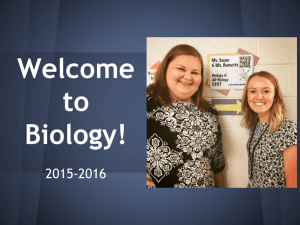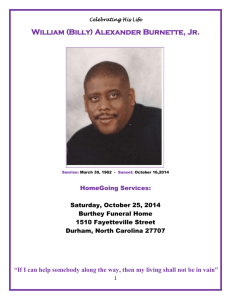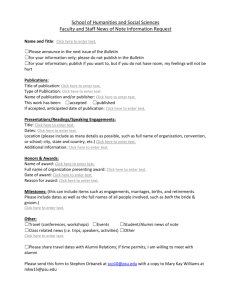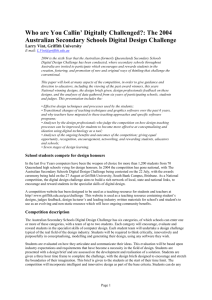ntegrator The Erik Josberger Wins Astronaut Scholarship In This Issue...
advertisement
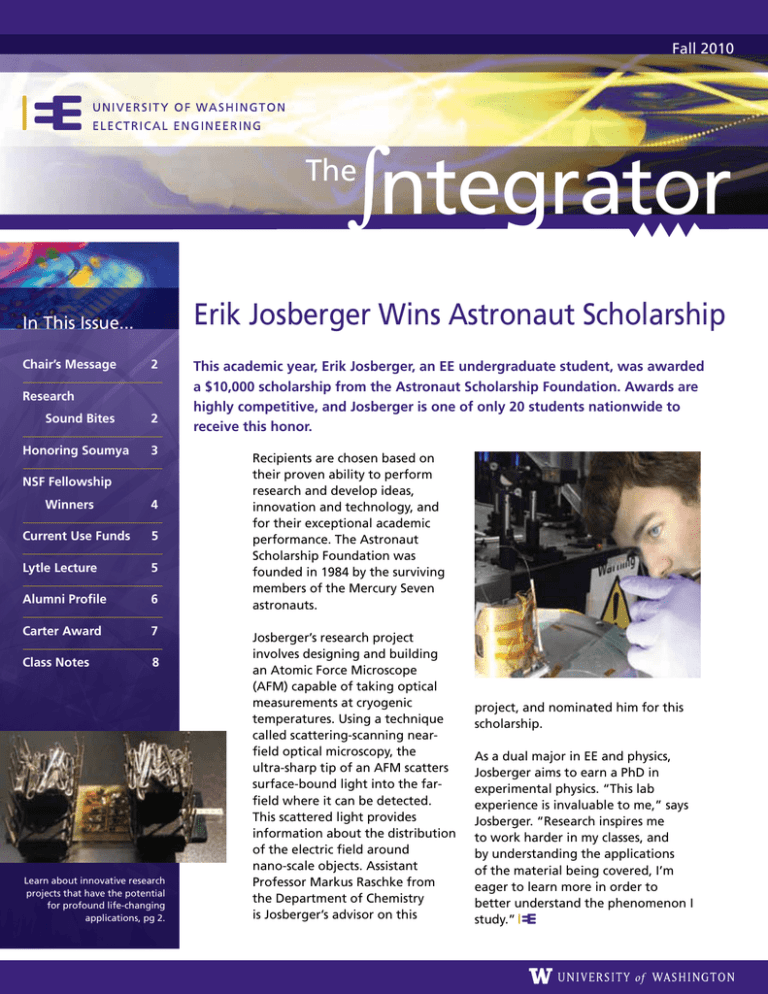
Fall 2010 The Erik Josberger Wins Astronaut Scholarship In This Issue... Chair’s Message 2 Research Sound Bites Honoring Soumya 2 3 NSF Fellowship Winners4 Current Use Funds 5 Lytle Lecture 5 ntegrator Alumni Profile 6 Carter Award 7 Class Notes 8 Learn about innovative research projects that have the potential for profound life-changing applications, pg 2. This academic year, Erik Josberger, an EE undergraduate student, was awarded a $10,000 scholarship from the Astronaut Scholarship Foundation. Awards are highly competitive, and Josberger is one of only 20 students nationwide to receive this honor. Recipients are chosen based on their proven ability to perform research and develop ideas, innovation and technology, and for their exceptional academic performance. The Astronaut Scholarship Foundation was founded in 1984 by the surviving members of the Mercury Seven astronauts. Josberger’s research project involves designing and building an Atomic Force Microscope (AFM) capable of taking optical measurements at cryogenic temperatures. Using a technique called scattering-scanning nearfield optical microscopy, the ultra-sharp tip of an AFM scatters surface-bound light into the farfield where it can be detected. This scattered light provides information about the distribution of the electric field around nano-scale objects. Assistant Professor Markus Raschke from the Department of Chemistry is Josberger’s advisor on this project, and nominated him for this scholarship. As a dual major in EE and physics, Josberger aims to earn a PhD in experimental physics. “This lab experience is invaluable to me,” says Josberger. “Research inspires me to work harder in my classes, and by understanding the applications of the material being covered, I’m eager to learn more in order to better understand the phenomenon I study.” Sound Bites on Research Message from the Chair The department marked a milestone in graduating the first class in the Professional Master’s Program (PMP) when 33 students received degrees in June. In just three years, enrollment has grown to 126 students, and I’m thrilled to report that the PMP is serving a need for both students and industry. Fall quarter got off to a great start when Dr. Thomas Kailath spoke at our third annual Dean Lytle Lecture Series on October 11. Dr. Kailath is the Hitachi America Professor of Engineering, Emeritus, at Stanford University, and it was a privilege for the UW EE community to hear him speak on the origins and impact of mathematical engineering. Some of our faculty and students are conducting fascinating research in microrobotics, low-power wireless sensors for home monitoring, and video compression with the potential for practical, life-changing applications. Brief stories on the following page highlight some of these projects. Faculty and students at UW EE are engaged in many innovative research projects that have the potential for profound life-changing applications. Here is just a sampling of a few projects that have gained noteworthy attention. For more in-depth information about the cutting-edge research happening in EE, check out the department’s annual research review, EEK (Electrical Engineering Kaleidoscope): www.ee.washington.edu/news/eek/index.html Home’s Electrical Wiring Acts as Antenna to Receive Low-Power Sensor Data Description: Researchers at UW and the Georgia Institute of Technology have devised a way to use copper electrical wiring in the walls of a home as a giant antenna to receive wireless signals at a set frequency. A low-power sensor placed within 10 to 15 feet of electrical wiring can use the antenna to send data to a single base station plugged in anywhere in the home. The device is called Sensor Nodes Utilizing Powerline Infrastructure, or SNUPI and uses less than 1 percent of the power for data transmission. Application: The technology could be used in home automation or healthcare. In home automation applications, SNUPI might be able to tell a homeowner when water is dripping into an attic crawl space, or where an open window is letting hot air escape during winter. Medical monitoring needs a compact device that can sense pulse, blood pressure or other properties and beam the information back to a central database, without requiring patients to replace the batteries. Read More: http://uwnews.org/article.asp?articleID=60338 Our students continue to receive top honors for their excellent work in research and academics. To name just a few, this year we have three NSF fellowship award winners and an Astronaut Scholarship winner (only 20 of the latter are awarded nationwide). Congratulations to these students! Leung Tsang Professor and Chair Photo by Gabe Cohn 2 The Integrator Vol 6:1, Fall 2010 Sign Language Via Cell Phones Description: The MobileASL project, led by EE Professor Eve Riskin and Professor Richard Ladner of Computer Science & Engineering, has been working to optimize compressed video signals for sign language. By increasing image quality around the face and hands, researchers have brought the data rate down to 30 kilobits per second while still delivering intelligible sign language. MobileASL also uses motion detection to identify when a person is signing in order to extend a phones’ battery life during video use. Application: These tiny mobile devices could someday crawl through cracks to explore collapsed structures, collect environmental samples or do other tasks where small size is a benefit. Read More: http://uwnews.org/article.asp?articleID=58979 Application: A phone or device that transmits sign language as efficiently as possible increases affordability, improves reliability on slower networks, and extends battery life, and thus facilitates accessibility of mobile communication technology for the deaf and hard-of hearing. Read More: http://uwnews.org/article.asp?articleid=59764 Honoring Dr. Soumyanath A “Professor” in Industry & Friend of EE On October 6th, 2010, the department lost a long-time friend and supporter, Dr. Krishnamurthy Soumyanath. “Soumya,” as he preferred to be called, was a former professor at Tufts University and a Fellow of Intel Corporation. Soumya was special to many at UW EE and among his colleagues at Intel because he embodied his favorite nickname, “Professor.” Some might assume that Soumya was called Photo by Mary Levin “Professor” because of his past academic experience. However, those who were fortunate enough to work closely with Thermal-powered Insect-like Microrobots Description: Professor Karl Böhringer’s lab and Stanford University have developed a centipede-like robot with 512 feet arranged in 128 sets of four. Each foot consists of an electrical wire sandwiched between two different materials, one of which expands under heat more than the other. A current traveling through the wire heats the two materials and one side expands, making the foot curl. Rows of feet shuffle along in this way at 20 to 30 times each second. Compared to other such robots, the UW model excels in its ability to carry heavy loads—more than seven times its own weight—and move in any direction. The UW’s robot weighs half a gram (roughly onehundredth of an ounce), measures about 1 inch long by a third of an inch wide, and is about the thickness of a fingernail. him knew it was a much more personal name given in respect and appreciation for his passion to develop new things that made a difference, but more importantly, for his role in developing people who would make a difference. His incredible support of interns, academics, and young engineers is legendary and truly exceptional among industrial leaders. Over the past decade, he was instrumental in developing some of the department’s top graduates, including Drs. Gaurab Banerjee, Cameron Charles, Jeyanandh Paramesh, Charles Peach, Sudip Shekhar, Jeffrey Walling, and current PhD students Anna Dixon, Daibashish Gangopadhyay, Parmoon Seddighrad and Sangmin Yoo. He was a wonderful person and we will miss him greatly. The Integrator Vol 6:1, Fall 2010 3 Three EE Students Win NSF Fellowships The department is honored that three doctoral students won NSF fellowships this academic year. “It is impressive that three of our students have received this prestigious award,” says Leung Tsang, professor and chair. “Each is in a different research area within the department, which speaks volumes about our research program.” National Science Foundation Graduate Research Fellowship Program (GRFP) awards provide three years of support including an annual stipend, cost-of-education allowance, an international travel allowance, and TeraGrid supercomputer access. To learn more about EE NSF fellowship winners and their research area, please read below. Student: Gabe Cohn Advisor: Shwetak Patel Research Area: Ubiquitous Computing Cohn’s research focuses on enabling new ultra-low-power sensing solutions for the home environment which will revolutionize sensing and home automation, making smart homes potentially more affordable for everyone. In addition, Cohn also creates novel human-computer interfaces, which will change the way that people interact with computers in daily life, making it easier and more natural to use the full potential of today’s computing power. Student: Linda Bai Advisor: Sumit Roy Research Area: Communications & Networking As any large network (internet) grows in size and diversity (types of nodes), it becomes exponentially harder to monitor link-level properties (e.g., delay, loss rate) of interest. Thus, network monitoring as a key component of overall network management is an area of great practical interest for both efficiency and security purposes. Unfortunately, this area has developed largely as a set of ad-hoc practices on one hand, while the foundational statistical approaches have not scaled with network growth. Bai’s research develops a new theory and algorithmic practice for network management to enhance the computing infrastructure for research and education. Student: Julie Medero Advisor: Mari Ostendorf Research Area: Statistical Language Processing Medero’s research looks at ways to automatically make texts easier to read. She is interested in what makes things hard to read (hard words, hard sentence structures, difficult content) and how those factors are different for different groups of readers, including low-literacy adults, second language learners, and children. Medero’s goal is to use machine learning and natural language processing techniques to develop a simplification system that could be adapted to each of those different user groups. 4 The Integrator Vol 6:1, Fall 2010 Current Use Funds Gaining Popularity Given current economic conditions, many EE alumni are opting to give to Kailath Delivers 2010 Lytle Lecture The department was delighted to have Dr. Thomas Kailath, the Hitachi America Professor of Engineering, Emeritus from Stanford University, deliver the third annual Dean Lytle Electrical Engineering Endowed Lecture. “current use” funds that provide immediate support. Recently, EE alumnus John Brew (BSEE ’82, MSEE ’93), and his wife Mary Ellen Asmundson, established the Brew Fellowship in Electrical Engineering, a current use fund that will provide support for three years to a graduate research assistant working with a highperforming mid-career faculty member in the Department of Electrical Engineering. This creative new method of providing support appealed to John because it benefits EE students immediately. “Graduate fellowships are in short supply, but are essential for attracting and retaining the most outstanding graduate students in a tremendously competitive recruiting environment.” John hopes that other EE alumni will see the value in current use gifts and join him. “Tuition increased 14% this year and is expected to increase by the same amount next year. If we want to continue to compete for the best and the brightest, we need to bolster the amount of support we can offer prospective students.” For more information about current use funds, contact Mahnaz Sherzoi at mahnaz@u.washington.edu or call (206) 685-1927. Kailath has been a renowned faculty member of Stanford University since 1963. His research has ranged over several fields of engineering and mathematics, including information theory, communications, linear systems, estimation and control, signal processing, semiconductor manufacturing, probability and statistics, matrix and operator theory. He has also co-founded and served as a director for several private and public high-technology companies. As a mentor to a stellar array of about one hundred doctoral and postdoctoral scholars, their joint efforts have produced over 300 journal papers (many of which have received outstanding paper prizes), a dozen patents, and several books and monographs. “Dr. Kailath is such a distinguished member of our field, and it was an honor to have him deliver the Lytle Lecture this year,” said EE chair Leung Tsang. Kailath received a BE (telecom) degree from Poona University in 1956, and MS (1959) and ScD (1961) degrees in electrical engineering from MIT. After a year at the Jet Propulsion Laboratories, he joined Stanford University in 1963. He also received several honorary degrees from universities in Sweden, Scotland, Spain, France and India. Among his many honors are: the Shannon Award of the IEEE Information Theory Society; the Education and Signal Processing Society Medals of the IEEE; the IEEE Medal of Honor; Guggenheim, Churchill and Humboldt Fellowships; and election to the US National Academy of Engineering, the US National Academy of Sciences, the American Academy of Arts and Sciences, and the Silicon Valley Engineering Hall of Fame. His latest major honors are the Padma Bhushan, India’s third highest civilian award, presented by the president of India in April 2009; Foreign Membership of the Royal Society (London) in July 2009; the Blaise Pascal Medal of the European Academy of Sciences in November 2009 and the BBVA Frontiers of Knowledge award in Information and Communication Technologies in June 2010. The Integrator Vol 6:1, Fall 2010 5 dent, Dave Gibbons, burst out of his office one day asking for Burnette. “We had never met, but he heard I spoke Spanish and asked me to talk on the phone with a customer calling from Spain, where I had lived for a while,” Burnette said. “Dave asked me to organize a product demonstration for the customer and sent me to Spain with another engineer. He didn’t care that I was just an intern.” Though he had no idea at the time, that brief encounter planted important seeds for his future. John Burnette: A Go-to-Guy and Go-Getter John Burnette has been a go-getter since high school when he enrolled in a community college Running Start program. A first-quarter physics class of 36 students dwindled to just 12 the next quarter, and by the third quarter he was one of just three students “left standing.” At age 16 he started his own business and found he could make far more money than if he took a “normal” job like his classmates. As a UW EE undergraduate with an internship at a local company, he busted the “lowly intern” image by always asking for more work when finishing a project early, and even taking on a professional-level assignment. Fast-forward eight years, and Burnette (BS ‘03, MS ’05) has finished his coursework and qualifying exams for his EE PhD and is taking a leave of absence to serve as director of engineering for a company for which he was a founding team member in 2005 and is now “really taking off.” The work stories Burnette tells reveal he is not just a go-getter, but also an adept bridger of the leftbrain, right-brain divide. He has the finely honed analytical and problem-solving skills of a first-rate engineer, along with a rock-solid work ethic and values that prize responsi6 The Integrator Vol 6:1, Fall 2010 bility and fulfilling commitments on time. He also has an easy sense of humor accompanying great people skills, plus good intuition, risk-taking inclinations, the ability to fly fearlessly by the seat of his pants, and a propensity for attracting out-of-the-blue opportunities that open unexpected doors. “My dad taught me that I didn’t have to do the same thing as everyone else. I learned if you want things most people don’t have, you must be willing to do what most people aren’t, including putting in extra effort, taking some risks, and bouncing back when it doesn’t work out,” Burnette said. One opportunity came during his six-month undergraduate internship at Elektrobit, a design house for cell phone providers. The presi- In 2003, a call from Elektrobit put him in Dave Gibbon’s office for just the second time. A huge electronics company in Monterrey, Mexico, had hired Elektrobit to solve a problem with product testing software that was failing 90% of the devices as they came off the manufacturing line. Gibbons asked him if he had ever programmed in LabView. Burnette said no, but was sure he could figure it out. “Gibbons got on the phone with the customer and said ‘I have an engineer here who is a LabView expert. He speaks Spanish and you will love him,’ Burnette recalled with a laugh. “Four hours later I was on a plane to Monterrey doing LabView tutorials on my laptop. You know, it wasn’t long before I was an expert.” Working about 75 hours a week on contract for six weeks, he helped resolve all the problems ahead of schedule. Then it was back to the UW to begin his master’s work with Professor Tom Furness in the HIT Lab. He researched the use of short-pulsed radar to determine the feasibility of a wearable tracking device with closely placed antennas. By the time he finished his MS, Burnette knew he wanted to be an entrepreneur, but had no idea how to go about it. “I thought if I started on doctoral work I could build a network, meet the right people, then start my own company.” Out of the blue, Gibbons called after two years of no contact. “He had just left Elektrobit, and invited me for coffee to hear his idea for starting a new company. He needed a good engineer to help get it going,” Burnette said. Since that pivotal call, Opanga Networks has developed innovative technology to help wireless companies move high-bandwidth video more efficiently over networks by finding and using surplus capacity in realtime. “Streaming video is the number one problem causing service disruption over wireless networks,” Burnette said. “Our solution is unique in that it does not require network operators to build additional capacity or put in special equipment. We cache video directly to consumer devices without adding congestion, by using otherwise wasted surplus capacity.” In the startup years Burnette worked for little or no pay, while developing the technology and joining Gibbons to seek investments from “local billionaires to cousins of Saudi princes, really anyone who would listen.” He made ends meet while working in the HIT lab, RATLab LLC, and later Eden Rock Communications, and also completed the coursework and qualifying exams for his doctoral degree. Opanga now has excellent financial backing, all from Seattle angel investors, plus 35 patent applications, a small engineering office in Redmond and an engineering office in Monterrey, Mexico. In December, a major telecommunications client in Mexico will be the first product launch customer. Burnette has received permission to take a leave of absence from his PhD program to work fulltime at Opanga to supervise the company’s ten engineers (all UW grads in the Redmond office) and two UW undergrad interns, all “exceptional.” And the future? “Opanga is doing great and increasingly attracting attention, and we expect a big telecom or service provider will want to acquire it in a few years,” Burnette said. Even though he’s built his business network, Burnette intends to finish his doctoral degree and then start anew as an entrepreneur and enthusiastic go-getter. “None of this was possible without the support and encouragement of my wife,” Burnette says. Alomair Wins the 2010 IEEE/IFIP William C. Carter Award Basel Alomair, a PhD student of UW EE’s Network Security Lab (NSL), received the prestigious 2010 IEEE/IFIP William C. Carter Award at the 40th Annual IEEE/IFIP International Conference on Dependable Systems and Networks in Chicago, Illinois. His paper titled, “Scalable RFID Systems: a Privacy-Preserving Protocol with Constant-Time Identification” was co-authored by EE PhD student Andrew Clark, Dr. Jorge Cuellar from Siemens, Germany, and Professor Radha Poovendran. A patent on this work has also been filed through the UW’s Center for Commercialization. pendable Computing and Fault Tolerance since 1997, the Carter Award is considered to be one of the most important awards in the field of dependable computing. The late William C. Carter was a key figure in forming and developing the field of dependable computing, and he took great interest in promoting the work of young contributors. The purpose of the award is to honor the late William C. Carter, and recognize individuals who have made a significant contribution to the field through his or her graduate dissertation research. Sponsored by the IEEE Technical Com- “Our focus is to train and place stumittee on Fault-Tolerant Computing dents and transition emerging techand the IFIP Working Group on Denologies to industry in the area of wireless security,” says Professor Poovendran. As RFID enters the mainstream of commercialization, researchers have been grappling with the problem of finding cost-effective, scalable solutions for privacy-preserving tag identification. Alomair’s work exploits the fact that memory is relatively cheap. Some ultra-high-volume applications of RFID that can benefit from this work include commercial inventory of items, tracking airplane parts and identification of individuals at airports using e-passports. The Integrator Vol 6:1, Fall 2010 7 The ntegrator Website: www.ee.washington.edu | Tel: 206.221.5270 | Fax: 206.543.3842 To learn about supporting EE, please call 206.685.1927, or visit www.ee.washington.edu/supportee Leung Tsang Professor & Chair Sumit Roy Associate Chair for Research & Development University Of Washington Department of Electrical Engineering Paul G. Allen Center - Room AE 100R Box 352500 Seattle, Washington 98195-2500 James A. Ritcey Associate Chair for Education Laura J. Haas Publications Manager Contributors Sandy Marvinney Send address corrections to: alumni_relations@ee.washington.edu Alumni on the Radar - EE Class Notes We’d like to hear from you! Check out our Alumni Connections web page to read a complete list of updates from your former classmates, or to provide your own: www.ee.washington.edu/people/alumni/index.html Brianne Foster, BSEE ’10 Everett, WA – Foster interned at PBA throughout college and was placed in a local position, which allowed her to stay close to friends and family. She was able to start at her permanent position before she graduated and says it is the best place she could imagine working. Rich Snider, BSEE ’10 Bellevue, WA – After graduation, Snider spent six weeks in Kolkata, India. He led a team of four computer scientists and engineers to develop the flash game Hello Worlds! which is playable on Kongregate. In about two weeks, over one million people played their game online at three of the eight websites that have a licensed copy. Charles Kao, BSEE ’08 Redmond, WA – Kao has been working for two years, primarily in verification and validation as well as some hardware and software design. Kao is looking take the necessary exams to go to graduate school. Kevin Tomsovic, MSEE ’84, PhD ’87 Knoxville, TN – Tomsovic is the EE and CS department head and CTI professor at the University of Tennessee, Knoxville. After graduating, he spent a year at MIT Lincoln Labs in Boston, and then spent three years in Taiwan at National Cheng Kung University and National Sun Yat-Sen University. From Taiwan, he headed to the Royal Institute of Technology in Stockholm for a year. He finally settled at Washington State University where he was on faculty from 1992 to 2008. He held the Advanced Technology for Electrical Energy Chair at Kumamoto University, Japan, from 1999 to 2000 and was an NSF program director in the ECS division from 2004 to 2006. He joined University of Tennessee in January 2008. He is a fellow of the IEEE. Despite this wanderlust, he is tolerated by his wife Chien-fei and daughters Yukai and YiAn.


